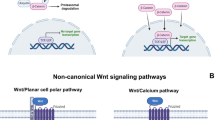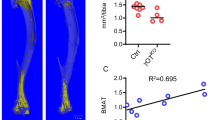Abstract
Hip fracture and myocardial infarction cause significant morbidity and mortality. In vivo studies raising serum cholesterol levels as well as pro-inflammatory cytokines such as TNF α manifest bone loss and atherosclerotic vascular disease, suggesting that abnormalities of cholesterol transport may contribute to osteoporosis. We used the mouse osteocyte cell line (MLO-Y4) to investigate the effects of TNF α on the expression of cholesterol acceptor proteins such as apolipoprotein A-I (apo A-I) and apolipoprotein E (apo E), as well as on the cholesterol transporters ATP-binding cassette-1 (ABCA1), scavenger receptor class B type 1 (SRB1), and cluster of differentiation 36 (CD36). MLO-Y4 cells do not express apo A-I or apo E; however, they do express all three cholesterol transporters (ABCA1, SRB1, and CD36). Treatment of MLO-Y4 cells with TNF α had no effect on SRB1, CD36, and osteocalcin levels; however, TNF α reduced ABCA1 protein levels in a dose-dependent manner and cholesterol efflux to apo A-I. Interestingly, TNF α treatment increased ABCA1 promoter activity and ABCA1 mRNA levels, and increased liver X receptor α protein expression, but had no effect on retinoid X receptor α and retinoic acid receptor α levels. Pharmacological inhibition of p38 mitogen-activated protein (MAP) kinase, but not c-jun-N-terminal kinase 1 or mitogen-activated protein kinase (MEK), restored ABCA1 protein levels in TNF α-treated cells. These results suggest that pro-inflammatory cytokines regulate cholesterol metabolism in osteocytes in part by suppressing ABCA1 levels post-translationally in a p38 MAP kinase-dependent manner.








Similar content being viewed by others
References
Elkeles A (1968) Studies on osteoporosis. Br Med J 4:582
Anderson JB, Barnett E, Nordin BE (1964) The relation between osteoporosis and aortic calcification. Br J Radiol 37:910–912
Marcovitz PA, Tran HH, Franklin BA, O’Neill WW, Yerkey M, Boura J, Kleerekoper M, Dickinson CZ (2005) Usefulness of bone mineral density to predict significant coronary artery disease. Am J Cardiol 96:1059–1063
Lee NK, Sowa H, Hinoi E, Ferron M, Ahn JD, Confaverux C, Dacquin R, Mee PJ, McKee MD, Jung DY, Zhang Z, Kim JK, Mauvais-Jarvis F, Ducy P, Karsenty G (2007) Endocrine regulation of energy metabolism by the skeleton. Cell 130:456–469
Ferron M, Hinoi E, Karsenty G, Ducy P (2008) Osteocalcin differentially regulates beta cell and adipocyte gene expression and affects the development of metabolic diseases in wild-type mice. Proc Natl Acad Sci USA 105:5266–5270. doi:10.1073/pnas.0711119105
Fontova R, Gutierrez C, Vendrell J, Broch M, Vendrell I, Simon I, Fernández-Real JM, Richart C (2002) Bone mineral mass is associated with interleukin 1 receptor autoantigen and TNF-alpha gene polymorphisms in post-menopausal Mediterranean women. J Endocrinol Invest 25:684–690
Parra-Rojas I, Ruiz-Madrigal B, Martinez-Lopez E, Panduro A (2006) Influence of the -308 TNF-alpha and -174 IL-6 polymorphisms on lipid profile in Mexican subjects. Hereditas 143:167–172
Li Y, Li A, Strait K, Zhang H, Nanes MS, Weitzmann MN (2007) Endogenous TNFalpha lowers maximum bone mass and inhibits osteoblastic Smad activation through NF-kappaB. J Bone Miner Res 22:646–655
Tintut Y, Demer LL (2014) Effects of bioactive lipids and lipoproteins on bone. Trends Endocrinol Metabol 25:53–59. doi:10.1016/j.tem.2013.10.001
Niemeier A, Niedzielska D, Secer R, Schilling A, Merkel M, Enrich C, Rensen PCN, Heeren J (2008) Uptake of postprandial lipoproteins into bone in vivo: impact on osteoblast function. Bone 43:230–237. doi:10.1016/j.bone.2008.03.022
Dallas SL, Prideaux M, Bonewald LF (2013) The osteocyte: an endocrine cell and more. Endocrine Rev 34:658–690. doi:10.1210/er.2012-1026
Zhang K, Barragan-Adjemian C, Ye L, Kotha S, Dallas M, Lu Y, Zhao S, Harris M, Harris SE, Feng JQ, Bonewald LF (2006) E11/gp38 selective expression in osteocytes: regulation by mechanical strain and role in dendrite elongation. Mol Cell Biol 26:4539–4552
Waters KM, Jacobs JM, Gritsenko MA, Karin NJ (2011) Regulation of gene expression and subcellular protein distribution in MLO-Y4 osteocyte cells by lysophosphatidic acid: relevance to dendrite outgrowth. Bone 48:1328–1335. doi:10.1016/j.bone.2011.02.020
Bodzioch M, Orso E, Klucken J, Langmann T, Böttcher A, Diederich W, Drobnik W, Barlage S, Büchler C, Porsch-Ozcürümez M, Kaminski WE, Hahmann HW, Oette K, Rothe G, Aslanidis C, Lackner KJ, Schmitz G (1999) The gene encoding ATP-binding cassette transporter 1 is mutated in Tangier disease. Nat Genet 22:347–351
Tarling EJ (2013) Expanding roles of ABCG1 and sterol transport. Curr Opin Lipidol 24:138–146. doi:10.1097/MOL.0b013e32835da122
Park YM (2014) CD36, a scavenger receptor implicated in atherosclerosis. Exp Mol Med 46:e99. doi:10.1038/emm.2014.38
Valacchi G, Sticozzi C, Lim Y, Pecorelli A (2011) Scavenger receptor class B type 1: a multifunctional receptor. Ann N Y Acad Sci 1229:E1–E7. doi:10.1111/j.1749-6632.2011.06205.x
Khovidhunkit W, Moser AH, Shigenaga JK, Grunfeld C, Feingold KR (2003) Endotoxin down-regulates ABCG5 and ABCG8 in mouse liver and ABCA1 and ABCG1 in J774 murine macrophages: differential role of LXR. J Lipid Res 44:1728–1736
Field FJ, Watt K, Mathur SN (2010) TNF-α decreases ABCA1 expression and attenuates HDL cholesterol efflux in the human intestinal cell line Caco-2. J Lipid Res 51:1407–1415. doi:10.1194/jlr.M002410
Smith PK, Krohn RI, Hermanson GT, Mallia AK, Gartner FH, Provenzano MD, Fujimoto EK, Goeke NM, Olson BJ, Klenk DC (1985) Measurement of protein using bicinchoninic acid. Anal Biochem 150:76–85
Herbomel P, Bourachot B, Yaniv M (1984) Two distinct enhancers with different cell specificities coexist in the regulatory region of polyoma. Cell 39:653–662
Chomczynski P, Sacchi N (1987) Single-step method of RNA isolation by acid guanidinium thiocyanate-phenol-chloroform extraction. Anal Biochem 132:6–13
Hirano K-I, Ikegami C, Zhang Z (2008) Contribution of CDC42 to cholesterol efflux in fibroblasts from Tangier Disease and Werner Syndrome. Meth Enzymol 439:159–169. doi:10.1016/S0076-6879(07)00412-0
Zhang Y, Ge C, Wang L, Liu X, Chen Y, Li M, Zhang M (2015) Induction of DKK1 by Ox-LDL negatively regulates intracellular lipid accumulation in macrophages. FEBS 589:52–58. doi:10.1016/j.febslet.2014.11.023
Costet P, Luo Y, Wang N, Tall AR (2000) Sterol-dependent transactivation of the ABC1 promoter by the liver X receptor/retinoid X receptor. J Biol Chem 275:28240–28245
Schwartz K, Lawn RM, Wade DP (2000) ABC1 gene expression and apo-AI-mediated cholesterol efflux are regulated by LXR. Biochem Biophys Res Commun 274:794–802
Costet P, Lalanne F, Gerbod-Giannone MC, Molina JR, Fu X, Lund EG, Gudas LJ, Tall AR (2003) Retinoic acid receptor-mediated induction of ABCA1 in macrophages. Mol Cell Biol 23:7756–7766
Guy GR, Chua SP, Wong NS, Ng SB, Tan YH (1991) Interleukin 1 and tumor necrosis factor activate common multiple protein kinases in human fibroblasts. J Biol Chem 266:14343–14352
Kyriakis JM, Avruch J (2001) Mammalian mitogen-activated protein kinase and signal transduction pathways activated by stress and inflammation. Physiol Rev 81:807–869
Yang H, Sadda MR, Yu V, Zeng Y, Lee TD, Ou X, Chen L, Lu SC (2003) Induction of human methionine adenosyltransferase 2A expression by tumor necrosis factor a. Role of NF-κB and AP-1. J Biol Chem 278:50887–50896
Bachner D, Schroeder D, Betat N, Ahrens M, Gross G (1999) Apolipoprotein E (ApoE), a BMP-2 (bone morphogenetic protein) upregulated gene in mesenchymal progenitors (C3H10T1/2), is highly expressed in murine embryonic development. BioFactors 9:11–17
Laskowitz DT, Lee DM, Schmechel D, Staats HF (2000) Altered immune responses in apolipoprotein E-deficient mice. J Lipid Res 41:613–620
Suda T, Takahashi N, Udagawa N, Jimi E, Gillespie MT, Martin TJ (1999) Modulation of osteoclast differentiation and function by the new members of the tumor necrosis factor receptor and ligand families. Endocr Rev 20:342–345
Rao A, Luo C, Hogan PC (1997) Transcription factors of the NFAT family: regulation and function. Annu Rev Immunol 15:707–747
Kim W-S, Kim HJ, Lee ZH, Lee Y, Kim H-H (2013) Apolipoprotein E inhibits osteoclast differentiation via regulation of c-Fos, NFATc1, and NF-κB. Exp Cell Res 319:436–446. doi:10.1016/j.yexcr.2012.12.004
Mogilenko DA, Shavva VS, Dizhe EB, Orlov SV, Perevozchikov AP (2010) PPARγ activates ABCA1 gene transcription but reduces the level of ABCA1 protein in HepG2 cells. Biochem Biophys Res Commun 402:477–482. doi:10.1016/j.bbrc.2010.10.053
Beigneux AP, Moser AH, Shigenega JK, Grunfeld C, Feingold KR (2000) The acute phase response is associated with retinoid X receptor repression in rodent liver. J Biol Chem 275:16390–16399
Beigneux AP, Moser AH, Shigenega JK, Grunfeld C, Feingold KR (2003) Sick euthyroid syndrome is associated with decreased TR expression and DNA binding in mouse liver. Am J Physiol Endocrinol Metab 284:E228–E236
Morishima A, Ohkubo N, Maeda N, Miki T, Mitsuda N (2003) NFκB regulates plasma apolipoprotein A-I and high density lipoprotein cholesterol through inhibition of peroxisome proliferator-activated receptor α. J Biol Chem 278:38188–38193
Aye IL, Singh AT, Keelan JA (2009) Transport of lipids by ABC proteins: interactions and implications for cellular toxicity, viability, and function. Chem Biol Interact 180:327–339. doi:10.1016/j.cbi.2009.04.012
Jessup W, Gelissen IC, Gaus K, Kritharides L (2006) Roles of ATP binding cassette transporters A1 and G1, scavenger receptor B1 and membrane lipid domains in cholesterol export from macrophages. Curr Opin Lipidol 17:247–257
Chang Y-C, Lee T-S, Chiang A-N (2012) Quercetin enhances ABCA1 expression and cholesterol efflux through a p38-dependent pathway in macrophages. J Lipid Res 53:1840–1850. doi:10.1194/jlr.M024471
Zhou X, Yin Z, Guo X, Hajjar DP, Han J (2010) Inhibition of ERK 1/2 and activation of liver X receptor synergistically induce macrophage ABCA1 expression and cholesterol efflux. J Biol Chem 285:6316–6326. doi:10.1074/jbc.M109.073601
Acknowledgments
This work was funded by a Grant from the University of Florida—Jacksonville College of Medicine to Dr. Kent Wehmeier.
Author information
Authors and Affiliations
Corresponding author
Ethics declarations
Conflict of Interest
Kent R. Wehmeier, William Kurban, Chandrikha Chandrasekharan, Luisa Onstead-Haas, Arshag D. Mooradian, and Michael J. Haas declare that they have no conflict of interest.
Human and Animal Rights and Informed Consent
This article does not contain any studies with human or animal subjects performed by any of the authors.
Rights and permissions
About this article
Cite this article
Wehmeier, K.R., Kurban, W., Chandrasekharan, C. et al. Inhibition of ABCA1 Protein Expression and Cholesterol Efflux by TNF α in MLO-Y4 Osteocytes. Calcif Tissue Int 98, 586–595 (2016). https://doi.org/10.1007/s00223-015-0106-2
Received:
Accepted:
Published:
Issue Date:
DOI: https://doi.org/10.1007/s00223-015-0106-2




